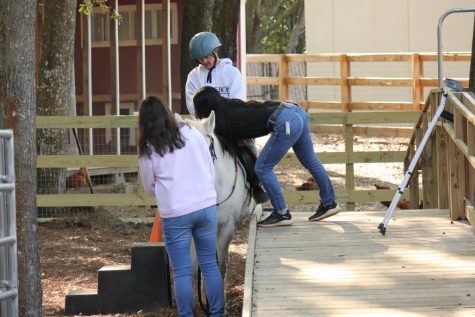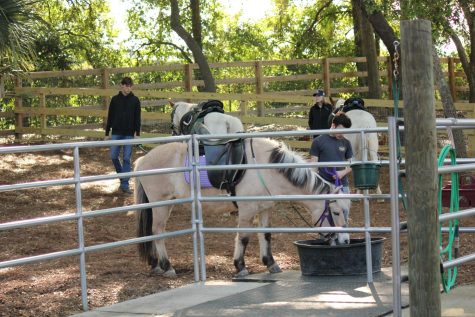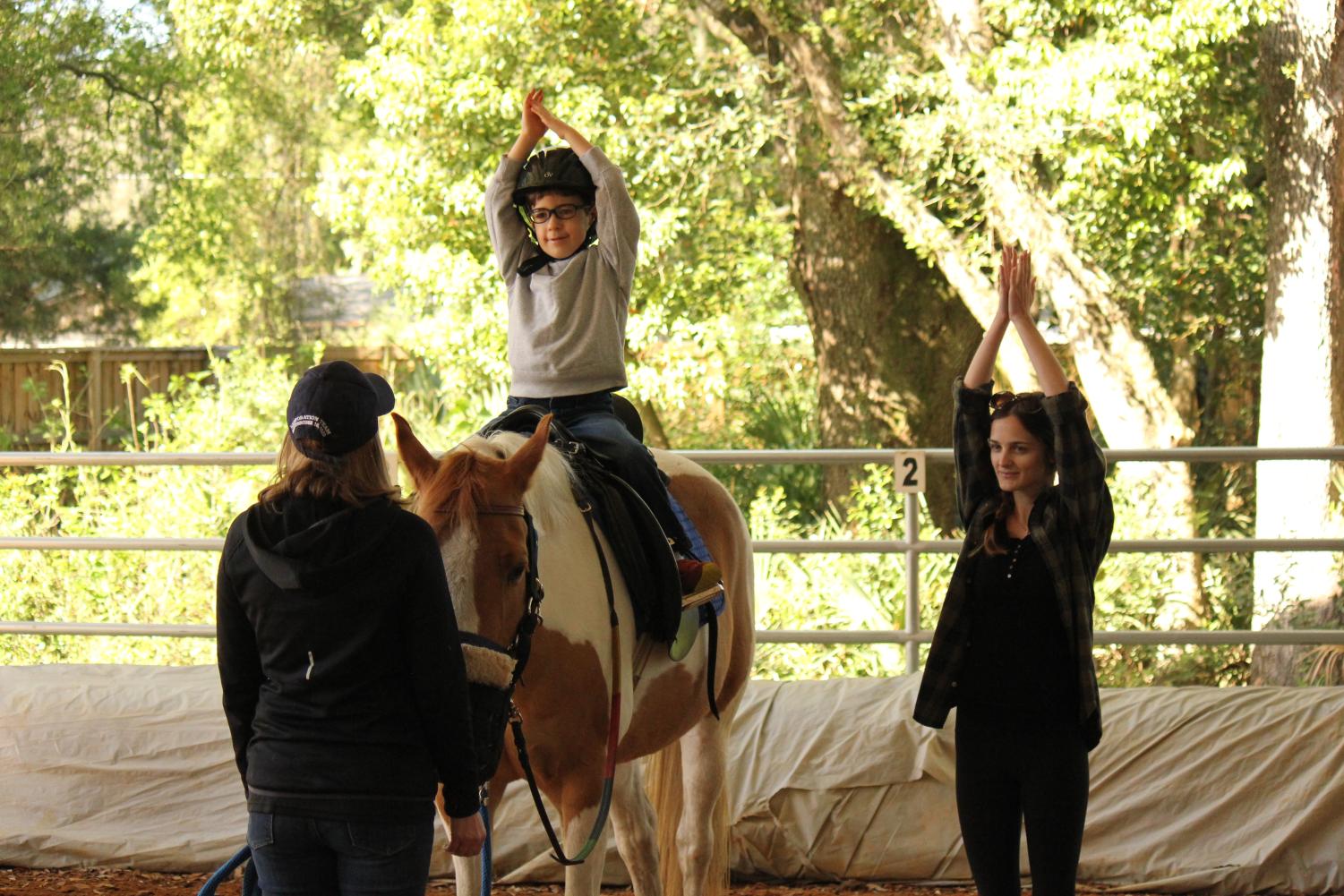Training to be a volunteer
Therapuetic riding at the Delores Barr Weaver Equestrian Center
May 3, 2022
Volunteers at the Delores Barr Weaver Therapeutic Equestrian Center have a plethora of morning duties such as feeding the chickens and pigs and collecting eggs to sell at their farmers’ market, and this is just the start of a busy, busy day.
After beginning the morning chores, Zoey Clontz, a college student with a big smile and a strong voice, instructs each of the six volunteers, all teens or in their early 20s, to get Izzy, Quinn, Ranger, and Chief ready for riding. Clontz noted, “The horses and the kids are the best part [of volunteering].”
The Equestrian Center’s website states, “Equine therapy helps children and adults with intellectual and developmental differences (IDD) reach their full potential by improving confidence, flexibility, balance, posture and muscle strength as well as psychological, cognitive, behavioral, social, and communication skills.”
There were three classes when I visited the center on March 25th, and then a volunteering training program. They started preparing for the first, but I didn’t see much of this because Sarah, a fellow volunteer along with Zoey, and I were busy wrangling the nosy pigs that just couldn’t stay out of the chicken coop.
Sarah is a 17-year-old Providence student that helped out as Zoey’s partner-in-crime and also showed me all around the barn. We spent the day together, and I learned that she is interested in veterinary science and psychology, which is why she decided to volunteer.
At around 9:00, kids start showing up for the first class, and on this day, there were four girls: Addison, Emily, Elizabeth, and Hailey, all of whom were under the age of 11. While they were probably tired from having such an early start to their Saturday, they still all triumphantly made their way up to the platform to mount their horses.
The kids sign up for seasonal sessions, six classes per session. This was their fifth class; a posture lesson.
All classes start out the same way with some stretching. Their stretches are animals themed, so they start with butterfly breathing and then follow up with some chicken stretches.
The stretches are meant to relax each of the kids before the class and make sure they get comfortable on the horses. Each of the volunteers follow along with the instructions and help any children that are struggling, but these girls were experts.
During their hour they had to work on keeping their posture straight while balancing bean bags on their feet and hands. The kids also practiced trotting on their horses and one girl was even able to do it all on her own.

After their class was over there was only about a 5-minute break until the next group showed up.
These students were a mixture of ages, and they were all super pumped to be riding.
I was truly impressed by the eagerness that some of these students had to ride their horses despite their physical disabilities.
The final class had only two kids in it, a brother and a sister, so there were two extra horses. I got to ride the horse named Chief.
Participating in the class was an amazing experience, and I was able to see why each of the kids have so much fun. They build a sense of independence and trust with their walkers (the people that guide their horses).
During the class, I had to balance colorful square beanbags on my feet to make sure my posture was good, and it was a lot more difficult than I thought. I don’t know how all of those kids could do it so easily. They fell off, a lot, but then, on the final run-through, not a single one fell. I made progress, but the kids had made more.
And then it was all over, but this wasn’t the end of the day.
After each class, the kids are taken on a sensory trail around the property that has lots of activities that draw to the five senses with activities such as throwing sticks into the correct colored tire and inspirational quotes that kids can read to each other.
Once all the fun and games are over and the kids go home, there’s a meeting with all the volunteers to discuss each kid’s progress throughout their session. Every volunteer tells Clontz what the kids can improve on and how the horses felt during the experience, so they can improve as well.
Finally, all the volunteers went home except for Clontz and Sarah, who started setting up for the volunteer training session. One woman, Debra, showed up for the volunteer training, and she and I were able to work together to practice what we would be doing as volunteers and what we would do with the horses to get them ready for the kids. We also worked on skills that would be used to make the children feel safe on the horses.

For example, first, we practiced side walking, where one volunteer creates a seatbelt with their arm over the child’s leg. This makes kids feel safer and sometimes there are two volunteers creating this seatbelt.
Then, we practiced leading, where one volunteer takes the horse and leads him/her in the direction that they need to go, to help the child steer better. Some children are so skilled that they don’t need the extra help any of these volunteers.
Finally, the day concluded at 2:45. I was tired, but I thoroughly enjoyed helping out and seeing what all the volunteers do. They truly make a difference and even work with participants in the Special Olympics. Each day, volunteers go to work and help kids learn, have fun, and increase their sense of confidence. So, if you or anyone you know might be interested in volunteering, scan the QR code below to sign up!

